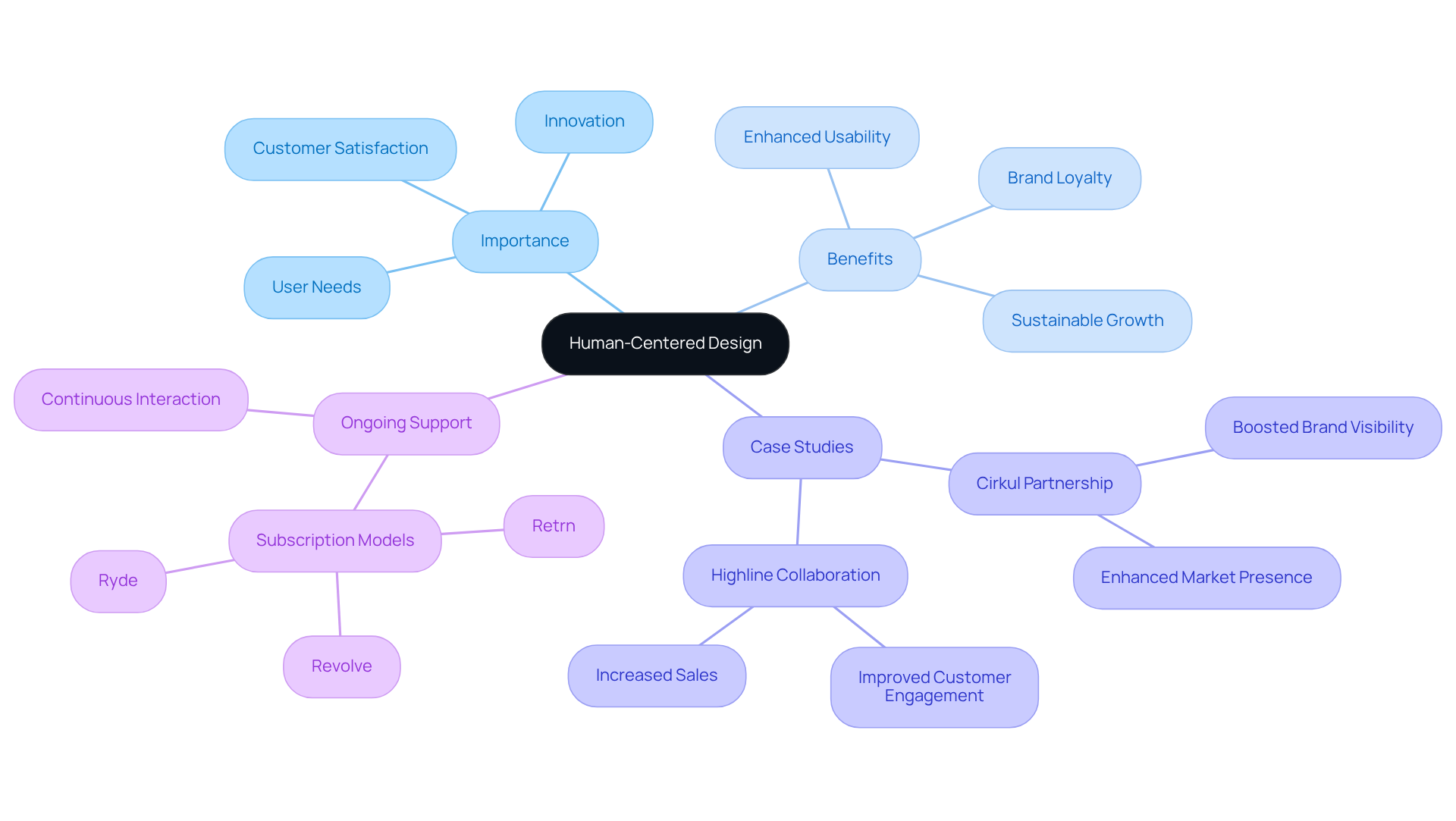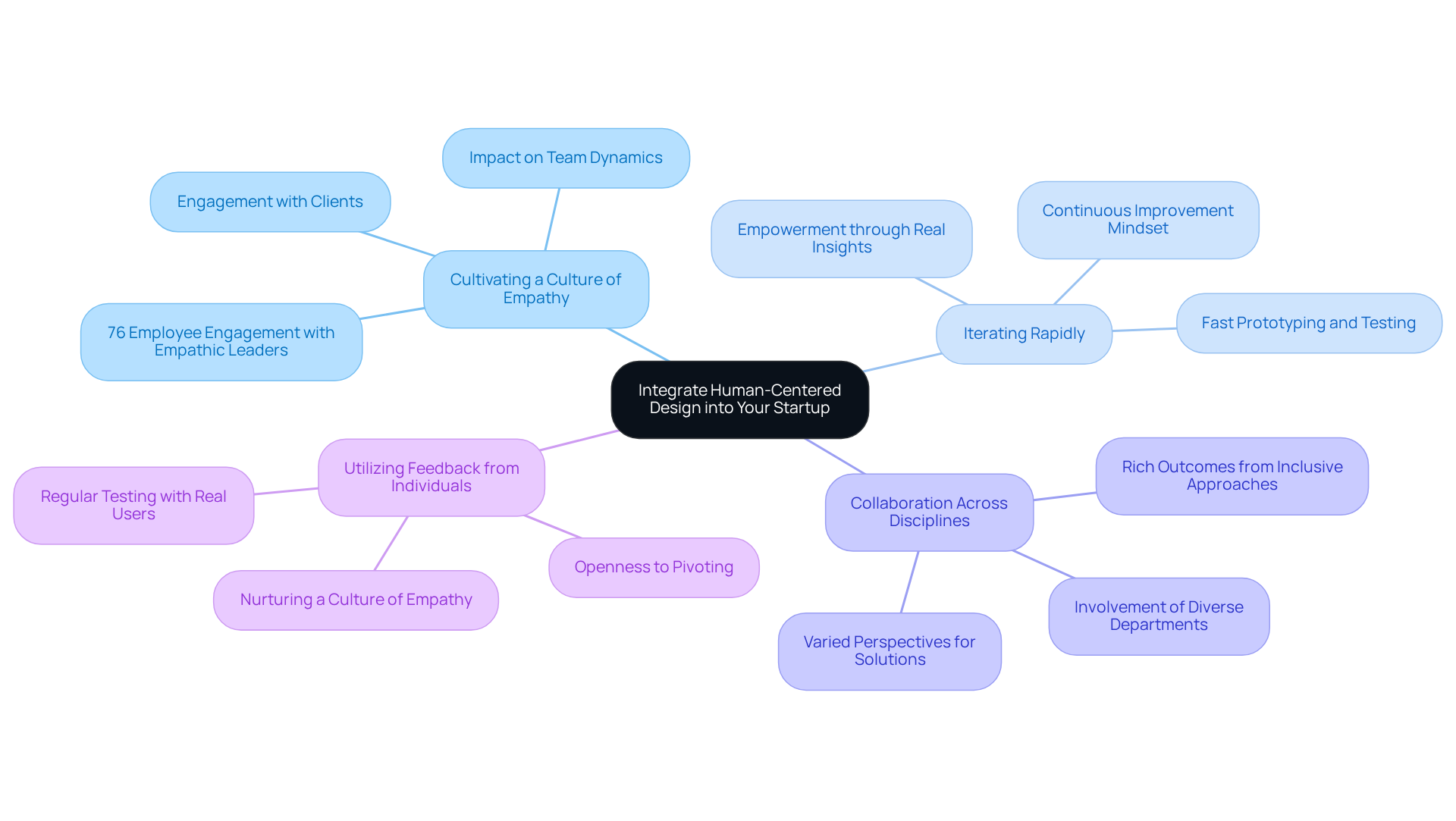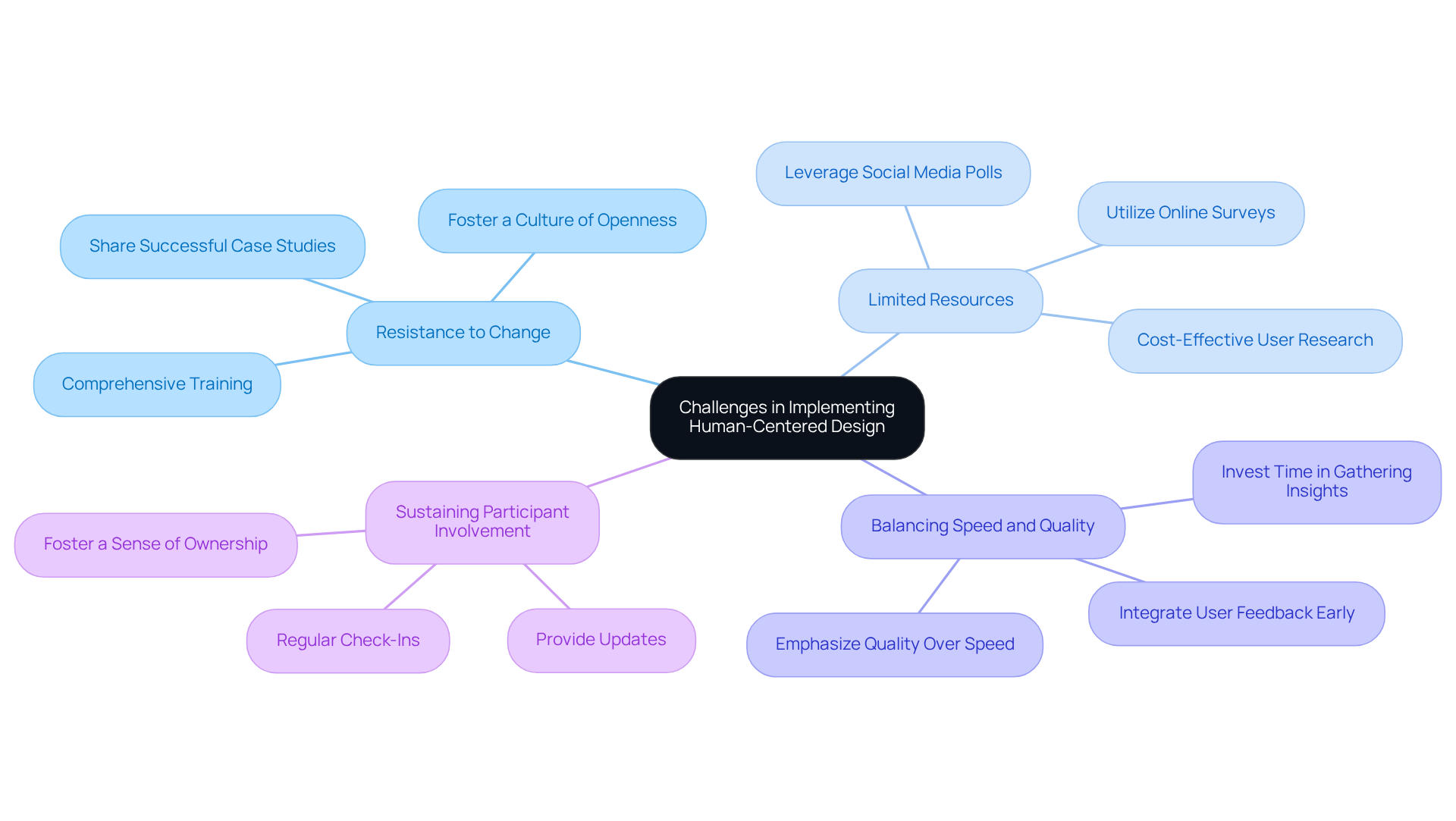Overview
In the journey of building a startup, one of the most pressing challenges founders face is the risk of failure—a reality that can be daunting. It's disheartening to learn that 42% of startups falter because they do not meet the market's needs. This statistic underscores the importance of truly understanding your users and their experiences.
When you engage with your target audience throughout the design process, you not only foster innovation but also build lasting customer loyalty. By mastering human-centered design (HCD), you can align your product development with what your users genuinely require, significantly reducing the likelihood of failure.
Embracing HCD is not just a strategy; it's a compassionate approach that nurtures both your business and your users. Together, we can navigate these challenges and create solutions that resonate deeply with those you aim to serve.
Introduction
Human-centered design has emerged as a vital framework for startups striving to thrive in today’s competitive marketplace. By prioritizing the needs and experiences of end-users, this approach not only nurtures innovation but also significantly enhances product usability. Yet, many startups find themselves grappling with the effective implementation of this design philosophy. This struggle often leads to missed opportunities and potential setbacks. How can new ventures harness the power of human-centered design to not only meet market demands but also forge lasting connections with their audience?
It’s important to recognize that the journey of applying human-centered design can feel overwhelming. Many founders share the frustration of pouring their hearts into a product, only to realize that it doesn’t resonate with their users. This disconnect can be disheartening, especially when the goal is to create meaningful solutions that truly address user needs.
However, there is hope. By embracing human-centered design, startups can transform their approach, ensuring that they not only meet market demands but also foster genuine relationships with their audience. This nurturing approach invites collaboration and understanding, paving the way for innovative solutions that resonate deeply with users. Together, we can explore how to effectively implement this compassionate design philosophy, creating products that not only succeed in the marketplace but also enrich the lives of those they serve.
Define Human-Centered Design and Its Importance for Startups
Human centered design serves as a guiding light for startups, prioritizing the needs, desires, and constraints of end-users in the design process. For new ventures, embracing human centered design is not only beneficial; it is essential. This approach not only fuels innovation but also ensures that offerings are functional and user-friendly. By focusing on , startups can sidestep the common pitfalls that lead to failure. In fact, data reveals that 42% of new businesses falter due to creating products that fail to meet market needs.
Engaging deeply with your target audience is crucial. It allows startups to gather invaluable insights that shape development and marketing strategies. This approach based on human centered design not only enhances customer satisfaction but also nurtures brand loyalty, both of which are vital for long-term success in a competitive landscape. As Donald A. Norman wisely noted, 'Human-centered design is a philosophy that assumes innovation should begin by engaging with individuals and observing their activities, rather than being a specific collection of techniques.'
Consider the case studies that illustrate the effectiveness of HCD:
- RNO1's collaboration with Cirkul led to a unique digital platform that significantly elevated the brand's visibility and market presence.
- Their partnership with Highline resulted in a customized digital experience that improved customer engagement and boosted sales.
These instances underscore the transformative potential of human centered design in driving development and innovation.
Moreover, RNO1's subscription models, such as Revolve, Retrn, and Ryde, provide ongoing support and expertise that are essential for effectively implementing HCD. This continuous interaction with clients ensures that new businesses can adapt to changing market demands while maintaining .
Ultimately, adopting a human centered design approach not only enhances product usability but also positions startups for sustainable growth and success in the ever-evolving digital landscape. Together, we can navigate these challenges and create solutions that truly resonate with your audience.

Explore the Phases of Human-Centered Design: Clarify, Ideate, Develop, and Implement
The process of human centered design is a vital journey for startups, encompassing four key phases: Clarify, Ideate, Develop, and Implement. Each phase plays an essential role in RNO1's transformative partnership with Figure, aiming to redefine compensation management in a way that truly meets the needs of individuals.
- Clarify: This initial phase is about understanding the people involved and their unique needs. Startups often face the challenge of identifying the problems they wish to solve. Conducting interviews, surveys, and observations can uncover valuable insights. As Daria Krasovskaya wisely states, "Conducting a brief UX Survey can assist you in discovering valuable insights about individuals' behavior and their expectations." RNO1 emphasizes a human-first approach, ensuring that the future employees' needs are at the forefront of the development process.
- Ideate: In this phase, teams come together to brainstorm potential solutions, generating a wide array of ideas without judgment. However, it’s crucial to avoid overwhelming users with choices. Scott Belsky's quote, "Rule of thumb for UX: More options, more problems," serves as a reminder to seek clarity during this phase. RNO1’s design strategy is rooted in simplicity and effectiveness, aligning seamlessly with Figure's mission to simplify compensation practices, ultimately alleviating the stress associated with decision-making.
- Develop: Here, startups create prototypes of their ideas, whether low-fidelity sketches or high-fidelity interactive models. Evaluating these prototypes with actual participants is essential. The significance of client research is underscored by the statistic that design-driven companies outperform their competitors by 228%. This highlights the importance of effective design in this phase. RNO1's commitment to design-focused solutions ensures that each prototype is crafted with experience in mind, enhancing for Figure's platform, which includes features like Interactive Offers and a comprehensive Compensation Management System.
- Implement: The final phase revolves around refining the product based on customer feedback and preparing for launch. Continuous iteration is key, as client needs may evolve over time. This iterative nature is crucial, as illustrated in the case study "Designer AI: Dashboard and Graphics for Fashion Service," which shows how ongoing research and adaptation can lead to successful design outcomes. RNO1's collaboration with Figure exemplifies this approach, ensuring that the final product not only meets but exceeds client expectations.
By following these stages, new ventures can navigate the complexities of human centered design with confidence. This process results in products that resonate with individuals, fostering success and creating a meaningful impact, much like RNO1's influential partnership with Figure.
Integrate Human-Centered Design into Your Startup: Strategies and Best Practices
To effectively integrate human centered design into your startup, it's essential to recognize the challenges you face and the impact they can have on your journey. Many founders struggle to connect deeply with their clients, which can lead to missed opportunities for innovation and growth.
- Cultivating a Culture of Empathy is a powerful solution. Encourage your team members to engage with clients regularly—through interviews, feedback sessions, or by observing them in their environments. This practice fosters empathy, which is vital for team dynamics. Research indicates that 76% of employees with are often or always engaged. Imagine the positive ripple effect this can have on your startup's creativity and collaboration.
- Next, consider the importance of Iterating Rapidly. Adopting a mindset of continuous improvement through agile methodologies can transform your approach. Fast prototyping and testing not only speed up feedback cycles but also empower your team to refine their ideas based on real insights from users. This iterative process can be incredibly rewarding, as it allows for growth and adaptation.
- Collaboration Across Disciplines is another key strategy. Involve team members from diverse departments—design, marketing, engineering—in your design process. This inclusive approach, rooted in human centered design, brings together varied perspectives that are essential for crafting solutions that truly meet the needs of your clients. When everyone contributes, the outcome is richer and more comprehensive.
- Lastly, make Utilizing Feedback from Individuals a cornerstone of your development process. Regularly testing your product with real users and being open to pivoting based on their insights not only enhances the product but also nurtures a culture of empathy within your team. Remember, empathetic leadership can ignite innovation and elevate your organization’s performance, making it a crucial element of your startup's success. By embracing these strategies, you can create a supportive environment that fosters growth and connection, ultimately leading to a thriving startup.

Troubleshoot Common Challenges in Implementing Human-Centered Design
Implementing human centered design can present several challenges that may feel overwhelming at times. Let's explore these common issues together and discover effective strategies to navigate them with compassion.
- Resistance to Change: It’s natural for team members to feel hesitant when faced with new methodologies, especially if they are accustomed to traditional development processes. To ease this transition, consider offering comprehensive training on human centered design principles. Sharing that demonstrate the effectiveness of human centered design can also inspire confidence and foster a culture of openness. This supportive approach can help everyone embrace the change together.
- Limited Resources: For many startups, budget constraints can be a significant hurdle. However, there are cost-effective methods for user research, such as online surveys or social media polls, that can yield valuable insights without straining finances. By adopting these methods, you can make informed choices while maintaining fiscal responsibility, ensuring that your innovative ideas can flourish without financial worry.
- Balancing Speed and Quality: The pressure to launch quickly can sometimes overshadow the importance of quality. It’s essential to emphasize the value of integrating user feedback early in the human centered design development process. This proactive approach not only helps to avoid costly mistakes later but also ensures that the final product effectively meets customer needs. Remember, taking the time to gather insights is an investment in your success.
- Sustaining Participant Involvement: Keeping individuals engaged throughout the creation process can be a challenge, but it’s vital for success. Regular check-ins and updates can help keep everyone informed and involved, making them feel valued and appreciated. This ongoing communication fosters a sense of ownership and commitment among users, ultimately enhancing the overall design outcome. Together, we can create something truly special.

Conclusion
For startups navigating the competitive landscape, embracing human-centered design is not just beneficial—it's essential. Many founders struggle with understanding user needs, which can lead to missed opportunities for innovation and product usability. This challenge can feel overwhelming, but by prioritizing user experiences, startups can transform their approach and foster deeper connections with their audience, paving the way for sustainable success.
Throughout this article, we've explored the vital aspects of human-centered design, including its significance for startups and the phases of the design process—Clarify, Ideate, Develop, and Implement. Each phase offers valuable insights, guiding you to better understand your users, generate creative solutions, and refine your products based on genuine feedback. It's also important to acknowledge the common hurdles, such as resistance to change and the delicate balance between speed and quality. Addressing these challenges will facilitate a smoother implementation of this crucial framework.
The importance of human-centered design truly cannot be overstated. By cultivating a culture of empathy, encouraging rapid iteration, and actively seeking user feedback, you can create products that resonate deeply with your audience. This approach not only enhances customer satisfaction but also nurtures brand loyalty—an essential ingredient for long-term growth. As you embark on this journey, remember that your commitment to understanding and serving your users will lead to innovative solutions that enrich lives and drive success in the marketplace. Together, let's embrace this path to create a brighter future for your startup.
Frequently Asked Questions
What is human-centered design (HCD)?
Human-centered design is an approach that prioritizes the needs, desires, and constraints of end-users in the design process, ensuring that products and services are functional and user-friendly.
Why is human-centered design important for startups?
HCD is essential for startups as it fuels innovation, enhances customer satisfaction, nurtures brand loyalty, and helps avoid common pitfalls that lead to business failure, such as creating products that do not meet market needs.
How does engaging with the target audience benefit startups?
Engaging deeply with the target audience allows startups to gather invaluable insights that inform development and marketing strategies, ultimately leading to improved customer satisfaction and brand loyalty.
What is a notable statistic regarding startup failures?
Data reveals that 42% of new businesses fail due to creating products that do not meet market needs.
Can you provide examples of successful human-centered design applications?
RNO1's collaboration with Cirkul created a unique digital platform that enhanced brand visibility, while their partnership with Highline resulted in a customized digital experience that improved customer engagement and boosted sales.
What ongoing support does RNO1 provide for implementing HCD?
RNO1 offers subscription models such as Revolve, Retrn, and Ryde, which provide ongoing support and expertise essential for effectively implementing human-centered design.
How does adopting HCD position startups for future success?
Adopting a human-centered design approach enhances product usability and positions startups for sustainable growth and success in a competitive and ever-evolving digital landscape.




